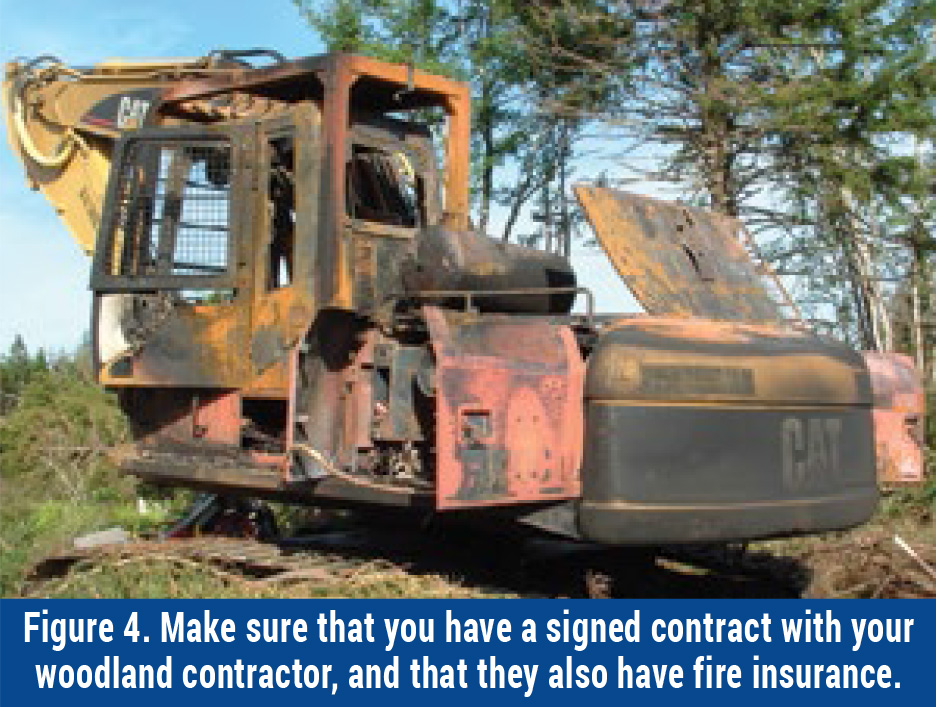Module 16: Wildfire and Your Woodland
Lesson 1 - Planning for Prevention
Planning for Prevention
Preventing wildfires is everyone’s responsibility. The old saying “an ounce of prevention is worth a pound of cure” is particularly applicable to wildfire prevention. It is clear that the ways in which we behave and interact with the forest will determine whether woodland fires result. If a fire does start and gets beyond our control, we must work with emergency response agencies—including fire departments and government—to reduce the chances of it spreading. But we never wish to reach this stage! Instead, we should plan to prevent wildfires. In doing so, we can avoid the necessity of expensive firefighting efforts and potentially devastating consequences.
Prudent Planning is Effective Prevention
As the owner of woodland, you have the responsibility of preventing and controlling fires on your property. Should a fire escape to an adjacent property and cause damage, you could be liable for repairing or paying for the resulting damages. Loss of trees and woodland use due to wildfire may be serious but loss of buildings and equipment can be worse.
Every woodland owner should adequately plan and actively employ reasonable precautions against fire. This includes scheduling woods work outside the times when risk of fire is high to prevent the ignition of fires and having the proper tools necessary to control a fire should one begin. Everyone working on or using your woodland property in any way, including for recreation, should have your permission and knowledge of what to do if a fire escapes.
For example, planning safe campfires is often overlooked by many people who enjoy the outdoors. The following diagram illustrates the precautions which must be taken around campfires. It can be used as a planning tool to help prevent your campfires from becoming wildfires.

As you plan for wildfire prevention, you should consider the following actions that will greatly enhance your ability to not only prevent wildfires but also encourage early wildfire suppression on your woodland:
• Maintain a daily log of your activities, including the fire weather index, and plan your woodland management activities accordingly. This information will help you in wildfire prevention and could prove valuable if a fire gets out of control.• Keep appropriate firefighting tools nearby and make sure they are in good condition.
• Keep a step-by-step checklist handy in case wildfire should occur. A checklist is essential during times when you may not be able to think clearly in the heat of the moment.
• Make sure that the civic number of your property, or some other means of identification, is prominently displayed at the end of your access road.
• Have your woodland management map or aerial photo readily available for firefighters should thy need it.
• Your woodland roads and bridges will be vital in firefighting efforts! Know their limits and whether they can support the weight of loaded fire trucks. The maximum weight capacity of each bridge should be clearly posted from both directions.
• Make sure there is unobstructed access to woodland ponds, which may be valuable as firefighting water sources.
Assurance through Wildfire Insurance
An important planning component that is often overlooked is making sure that you are adequately covered by fire insurance. Suppression costs of a major wildfire can easily escalate to hundreds of thousands of dollars. Owning an insurance policy that covers public liability and property damage can be of enormous benefit should a wildfire damage neighbouring property. Be sure to specify “fire damage” when discussing such a policy with your insurance agent. A minimum of $2 million in coverage is a good figure from which to begin.

If a woodland contractor is working on your property, you should have a signed written contract that describes the responsibilities and duties of each party. Many contractors have public liability and property damage insurance. Check the amount of coverage and whether fire damage is specified in the policy. Make sure the contract states that the contractor must have fire insurance and that the coverage is for a minimum of $2 million. This will help protect you in the event of a contractor-caused wildfire.
Planning for Wildfire Prevention: Other Considerations
Many of the steps that you can take to prevent wildfire are simple and easily accomplished. For example, working in the forest when the fire risk is extreme could be inviting disaster. Doing the same work earlier in the morning and later in the afternoon can prevent the worst from happening. This precaution should be extended to contractors who may be working on your property. Gauging the fire risk by checking the hazard index and being constantly aware of the conditions around you makes good sense and is a basic prelude to safely working on your woodland.
It is always a good policy to carry a mobile phone while in the woods. During fire season, a phone call will summon help if it is needed. Always make sure your phone is fully charged and never assume that firefighters can quickly find our location. Post the civic number of your property or your name at the road entrance, mark road intersections with flagging tape, and be prepared to give GPS coordinates if possible. For those working in remote locations, emergency GPS transmitters are available, which can provide an extra measure of security.

